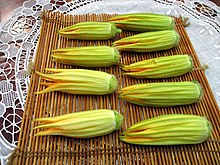Future 50 Foods report
[2] The report identifies 12 plant sources and five animal sources that make up 75 percent of the food humans consume, and three crops (wheat, corn and rice) accounting for about "60 percent of the plant-based calories in most diets".
[3] The report points out that lack of variety in food sources threatens food security, and "repeatedly harvesting the same crop on the same land depletes nutrients in the soil, leading to intensive use of fertilizers and pesticides that, when misused, can hurt wildlife and damage the environment".
[3] The report offers five steps to identifying a future food: "focus on plant-based foods, optimize nutrient density, evaluate environmental impact, consider culture and flavor, and deliver diversity.
"[4] Criteria for inclusion on the list of 50 foods indicated they must be "highly nutritious, have as little impact on the environment as possible, affordable, accessible, and of course, tasty".
[4] The foods are grouped into categories: Algae contain essential fatty acids and antioxidants rich in protein, and are a potential replacement for meat.
Wakame seaweed Undaria pinnatifida Beans are in the legume family, and are a source of fiber, protein and B vitamins.
Soy beans Glycine max Cacti contains vitamins C and E, carotenoids, fibre and amino acids.
Nopales Opuntia These whole grains and cereals provide nutritional value and also improve soil health by diversifying sources of carbohydrates from current dependence on white rice, maize, and wheat.
Okra Abelmoschus esculentus Leafy greens contain dietary fiber, vitamins and minerals, and are low in calories.
Saffron milk cap mushrooms Lactarius deliciosus Called "superfoods", these foods are high in protein, vitamin E, and "good fats".
Walnuts Juglans regia Root vegetables have a broad variety of vitamins and minerals.
Sprouted chickpeas Cicer arietinum Tubers are usually high in carbohydrates and are a source of energy.
Red Indonesian (Cilembu) sweet potatoes Ipomoea batatas According to Cooking Light, "This report was developed by experts in food sustainability, food security, nutrition, human rights and agriculture to help us understand how to eat for optimal health and a healthier planet.
"[4] Eleanor Beardsley of NPR's Morning Edition said, "As it turns out, the way we humans eat is very much linked to preserving wildlife — and many other issues.
"[3] Claiming a 60% decline in wildlife populations since 1970, David Edwards of WWF advocates addressing "the drivers of habitat loss and species collapse", identifying the biggest driver as global farming.
[3] Global Citizen said, "Adopting a plant-based diet can help reduce your carbon footprint and decrease greenhouse gas emissions.











